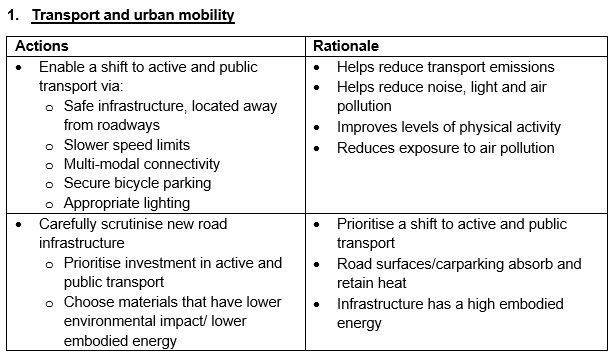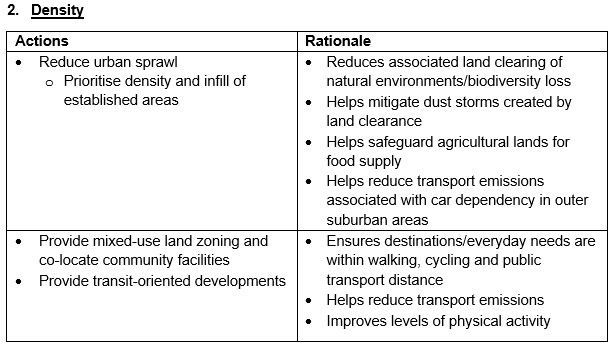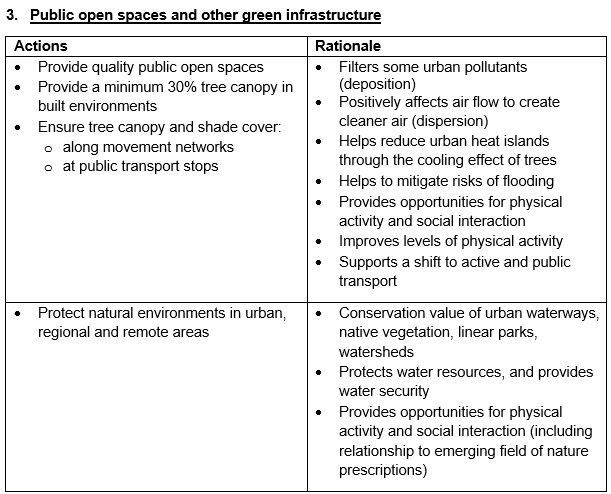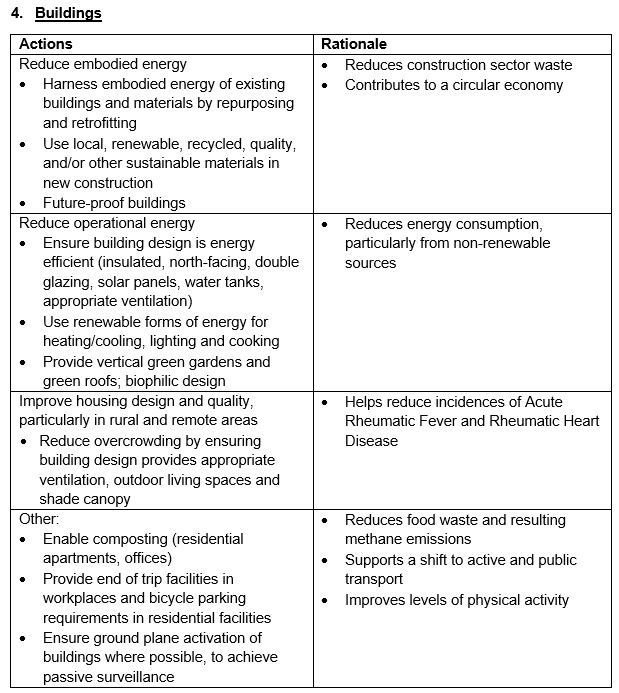Climate change, air pollution, cardiovascular disease and the built environment
Climate change, air pollution, cardiovascular disease and the built environment are inextricably linked.[1]
In addition to regular exercise and a healthy diet, fresh air, clean water, healthy soil and moderate temperatures are essential for cardiovascular health.[2] [3] These same environmental factors can also negatively affect cardiovascular health. These include the effects of air pollution from transport, light and noise pollution. As well as the effects of climate change through heat waves, bushfires, droughts, flooding and dust storms, and threats to food security and clean drinking water.
One significant way environmental factors relating to air pollution affect cardiovascular health is through exposure to particulate matter (PM) in the air. PM consists of tiny particles and liquid droplets that are suspended in the air. These are classified into various types including PM2.5, PM10, NOx and NO2.[4] PM2.5 particles are especially concerning as they are small enough to penetrate the respiratory system and potentially cause harm.[5]
In 2019, air pollution (both indoor and outdoor) was responsible for almost nine million deaths worldwide.[6] Of those, 70% of deaths caused by outdoor (ambient) air pollution were due to cardiovascular conditions.[7] Similarly, over half of all deaths related to household (indoor) air pollution were attributed to cardiovascular disease.[8] Moreover, air pollution has been cited as being the single greatest environmental health risk for cardiovascular conditions.[9]
Even with these known concerns, globally, from 2010 to 2019, the concentration of PM2.5 decreased by only 1% per year.[10] This demonstrates that more aggressive measures are needed to address air pollution and its harmful effects on cardiovascular health.
Environmental factors relating to climate change impact cardiovascular health because of greenhouse gases, of which carbon dioxide (CO2) is the main contributor.[11] CO2 is produced by the burning of fossil fuels including coal, oil, petrol and gas – mainly for the purposes of electricity, heat and transport.[12] The concentration of CO2 in the atmosphere acts as a blanket which traps heat near the earth’s surface, warming global temperatures and leading to extreme weather events.[13]
Between 2012 and 2022 extreme heat was responsible for 293 deaths and 7,104 hospitalisations in Australia.[14] [15] [16]
It has been established that more needs to be done to combat climate change to ensure that global temperatures do not exceed 1.5°C.[17] Temperature rises beyond 1.5°C would result in further severe weather events, impacting the health of populations and the natural environment on which we depend.[18] Furthermore, climate change is expected to increase the frequency, intensity, and spread of bushfires in Australia, as well as wildfires globally, which could exacerbate the cardiovascular impacts, outlined above, on PM2.5 levels.[19] [20]
The populations most at risk from cardiovascular disease related to air pollution and climate change are often the most vulnerable. This includes people with pre-existing cardiac conditions, First Nations peoples, the elderly, children, pregnant women, individuals with disabilities and those living in less advantaged areas.[21] Vulnerable populations are at greater risk of cardiovascular disease related to climate change and air pollution due to socio-economic and political factors.[22] These factors influence housing prices, land-zoning patterns and often have poor political representation. This can result in these populations living in environments where there are higher levels of indoor and outdoor pollution, and which are more susceptible to the impacts of climate change.[23] [24]
Actions to improve air quality and mitigate climate change can improve the cardiovascular health of all people living in Australia.[25]
Built environments – challenges
Built environments contribute to worsening climate change and air pollution, with cities being responsible for more than two thirds of the world’s carbon emissions.[26] The primary contributors are transport emissions and energy consumption.[27]
Transport emissions
Australia’s transport sector accounted for 19% of all emissions in 2022.[28] Of these emissions, 60% came from passenger cars and light commercial vehicles.[29] On our current trajectory, by 2030, the transport sector will become Australia’s largest source of emissions if intervention isn’t taken.[30]
In addition to being a major contributor to air pollution and climate change,[31] high levels of car dependency in Australian urban areas also contribute to physical inactivity, which further harms cardiovascular health. For example, in Perth, Western Australia, 2.8 million out of 4.2 million daily car trips are less than 5 kilometers.[32]
Energy consumption
The built environment consumes energy through embodied and operational emissions.
In 2023, embodied carbon emissions—those generated from producing materials and constructing buildings and infrastructure like roads—accounted for 10% of Australia’s total emissions.[33]
In addition, operational emissions, whether for heating, cooling, lighting or appliances, contributed to 18% of the country’s carbon emissions.[34] These emissions are major contributors to climate change and air pollution, exacerbating the overall environmental impact, and leading to adverse effects on cardiovascular health.[35]
Built environments – solutions
The design and implementation of the built environment also provides opportunities and solutions to help mitigate and reduce the impacts of climate change and air pollution (including the resulting effects on cardiovascular health).
Reducing private vehicle use is one of the most impactful actions we can take to improve air quality and mitigate climate change, while also increasing levels of physical activity.[36] This can be achieved by changing our mode of transport to active transport for greater participation in regular walking, cycling and use of public transport to get from point A to point B.[37]
To support this shift, we need a well-rounded approach that brings together different areas including transport and land use planning. By designing urban areas with the right balance of housing density and diversity, businesses and services, we can make sure that people can easily walk, cycle, or use public transport to reach everyday destinations. These include places like healthy food outlets, parks, schools, community centres, and workplaces.
The above actions to improve air quality and mitigate climate change can be achieved through policies, projects, programs, education, awareness and advocacy to create healthier, more walkable and sustainable built environments and local neighbourhoods.
The Heart Foundation supports built environment practitioners and decision makers to improve industry practice through Healthy Active by Design. The evidence-based digital toolkit is funded by the Australian Government’s Department of Health and Aged Care as part of our National Walking Initiative program. Suggestions on how we can improve our health through built environment improvements are listed below:
Useful resources, stakeholders and collaborators:
Doctors for the Environment Australia
Planning Institute of Australia
Australian Local Government Association
National Growth Areas Alliance
Green Building Council of Australia
Australian Sustainable Built Environment Council
Climate Works Centre, Australia
Australasian Green Infrastructure Network
References
[1] Department of Health and Aged Care, Australian Government, 2023, ‘National Health and Climate Strategy’,
https://www.health.gov.au/sites/default/files/2023-12/national-health-and-climate-strategy.pdf
[2] World Health Organisation, 2022, ‘Physical Activity’ Fact Sheet, accessed 29 November 2023, https://www.who.int/news-room/fact-sheets/detail/physical-activity
[3] Australian Institute of Health and Welfare, 2024, ‘Natural environment and health’, https://www.aihw.gov.au/reports/australias-health/natural-environment-and-health, date accessed 4 Sept 2024
[4] Alahmad B, Khraishah H, Althalji K, Borchert W, Al-Mulla F, Koutrakis P. Connections Between Air Pollution, Climate Change, and Cardiovascular Health. Can J Cardiol. 2023 Sep;39(9):1182-1190. doi: 10.1016/j.cjca.2023.03.025. Epub 2023 Apr 6. PMID: 37030516; PMCID: PMC11097327.
[5] Department of Climate Change E, the Environment and Water,. Australia State of the Environment 2021. 2021. https://soe.dcceew.gov.au/
[6] Miller M et. Al., 2024, ‘World Heart Report 2024 – Clearing the Air to address pollution’s cardiovascular health crisis’, World Heart Federation, https://world-heart-federation.org/wp-content/uploads/World_Heart_Report_Online.pdf
[7] Miller M et. Al., 2024, ‘World Heart Report 2024 – Clearing the Air to address pollution’s cardiovascular health crisis’, World Heart Federation, https://world-heart-federation.org/wp-content/uploads/World_Heart_Report_Online.pdf
[8] Miller M et. Al., 2024, ‘World Heart Report 2024 – Clearing the Air to address pollution’s cardiovascular health crisis’, World Heart Federation, https://world-heart-federation.org/wp-content/uploads/World_Heart_Report_Online.pdf
[9] Miller M et. Al., 2024, ‘World Heart Report 2024 – Clearing the Air to address pollution’s cardiovascular health crisis’, World Heart Federation, https://world-heart-federation.org/wp-content/uploads/World_Heart_Report_Online.pdf
[10] Miller M et. Al., 2024, ‘World Heart Report 2024 – Clearing the Air to address pollution’s cardiovascular health crisis’, World Heart Federation, https://world-heart-federation.org/wp-content/uploads/World_Heart_Report_Online.pdf
[11] Afifa, Arshad K, Hussain N, Hamza Ashraf M, Zafar Saleem M, 2024, ‘Air Pollution and Climate Change as grand challenges to sustainability’, Science Direct, Vol 928, 10 June 2024, https://doi.org/10.1016/j.scitotenv.2024.172370
[12] Commonwealth Scientific and Industrial Research Organisation,
[13] Bolan A, et. Al. 2024, ‘Impacts of Climate Change on the fate of contaminants through extreme weather events’, Science Direct, Vol 909, 20 Jan 2024, https://doi.org/10.1016/j.scitotenv.2023.168388
[14] WHO. Heat and health. World Health Organization. Available at: https://www.who.int/news-room/fact-sheets/detail/climate-change-heat-and-health. Accessed 7 Aug 2024.
[15] Ebi K, Capon A, Berry P, Broderick C, de Dear R, Havenith G et. Al., 2021, ‘Hot weather and heat extremes: health risks’, The Lancet vol 398 issue 10301 pp698-708, 21 August 2021
[16] Australian Institute of Health and Welfare, 2023, ‘Extreme weather is leading to more injury hospitalisations, with heat being the main cause, 2 Nov 2023, https://www.aihw.gov.au/news-media/media-releases/2023/2023-november/extreme-weather-is-leading-to-more-injury-hospitalisations-with-heat-being-the-main-cause#:~:text=There%20were%201%2C027%20injury%20hospitalisations,the%2010%2Dyear%20period%20analysed. Date accessed 4 Sept 2024
[17] United Nations Framework Convention on Climate Change, 2016, ‘The Paris Agreement’, https://unfccc.int/documents/184656, accessed 23 Sept 2024
[18] United Nations Framework Convention on Climate Change, 2016, ‘The Paris Agreement’, https://unfccc.int/documents/184656, accessed 23 Sept 2024
[19] Graham AM, Pringle KJ, Pope RJ, et al. Impact of the 2019/2020 Australian Megafires on Air Quality and Health. Geohealth. Oct 2021;5(10):e2021GH000454. doi:10.1029/2021gh000454
[20] Lucas C, Hennessy, K., Mills, G., Bathols, J. Bushfire weather in southeast Australia: Recent trends and projected climate change impacts. Vol. 84. 2007.
[21] Cooper N, Green D, Knibbs LD. Inequalities in exposure to the air pollutants PM2.5 and NO2 in Australia. Environmental Research Letters. 2019/11/06 2019;14(11):115005. doi:10.1088/1748-9326/ab486a and de Bont J, Jaganathan S, Dahlquist M, Persson Å, Stafoggia M, Ljungman P. Ambient air pollution and cardiovascular diseases: An umbrella review of systematic reviews and meta-analyses. J Intern Med. Jun 2022;291(6):779-800. doi:10.1111/joim.13467
[22] Cooper N, Green D, Knibbs LD. Inequalities in exposure to the air pollutants PM2.5 and NO2 in Australia. Environmental Research Letters. 2019/11/06 2019;14(11):115005. doi:10.1088/1748-9326/ab486a and de Bont J, Jaganathan S, Dahlquist M, Persson Å, Stafoggia M, Ljungman P. Ambient air pollution and cardiovascular diseases: An umbrella review of systematic reviews and meta-analyses. J Intern Med. Jun 2022;291(6):779-800. doi:10.1111/joim.13467
[23] Cooper N, Green D, Knibbs LD. Inequalities in exposure to the air pollutants PM2.5 and NO2 in Australia. Environmental Research Letters. 2019/11/06 2019;14(11):115005. doi:10.1088/1748-9326/ab486a and de Bont J, Jaganathan S, Dahlquist M, Persson Å, Stafoggia M, Ljungman P. Ambient air pollution and cardiovascular diseases: An umbrella review of systematic reviews and meta-analyses. J Intern Med. Jun 2022;291(6):779-800. doi:10.1111/joim.13467
[24] Putsoane T, Itai Bhanye J, Matamanda A, 2024, ‘Chapter 11 – Extreme weather events and health inequalities: Exploring vulnerability and resilience in marginalized communities’, Science Direct, Vol 15 2024, pp 225-248, https://doi.org/10.1016/B978-0-443-21948-1.00011-X
[25] Department of Health and Aged Care, Australian Government, 2023, ‘National Health and Climate Strategy’, https://www.health.gov.au/sites/default/files/2023-12/national-health-and-climate-strategy.pdf
[26] UN Habitat, n.d., ‘Climate Change’, https://unhabitat.org/topic/climate-change, date accessed 4 Sept 2024
[27] Delafoulhouze, M., 2021, ‘Cities in Australia are a major cause of emissions – but they can be a part of the climate solution too’, blog published 15 Nov 2021, Climateworks Centre, Melbourne, https://www.climateworkscentre.org/project/net-zero-cities/
[28] Department of Climate Change, Energy, the Environment and Water, 2024, ‘Reducing Transport Emissions’, https://www.dcceew.gov.au/energy/transport, date accessed: 27 August 2024
[29] Department of Climate Change, Energy, the Environment and Water, 2024, ‘Reducing Transport Emissions’, https://www.dcceew.gov.au/energy/transport, date accessed: 27 August 2024
[30] Climate Change Authority, 2024, ‘Sector Pathways Review: Transport’ https://www.climatechangeauthority.gov.au/sites/default/files/documents/2024-09/2024SectorPathwaysReviewTransport.pdf, accessed 20 Sept 2024
[31] Climate Council, 2017, ‘Transport Emissions: Driving Down Car Pollution in Cities’ Fact Sheet, https://www.climatecouncil.org.au/wp-content/uploads/2017/09/FactSheet-Transport.pdf date accessed 4 Sept 2024
[32] Mclaughlin M and De Gruyter C, 2024, ‘Hundreds of Cities have reached zero road deaths in a year. Here’s how they did it, University of Western Australia news article, 6 May 2024, https://www.uwa.edu.au/news/article/2024/may/hundreds-of-cities-have-achieved-zero-road-deaths-in-a-year-heres-how-they-did-it
[33] Infrastructure Australia, 2024, ‘Embodied Carbon projections for Australian Infrastructure and Buildings’, https://www.infrastructureaustralia.gov.au/reports/embodied-carbon-projections-australian-infrastructure-and-buildings, date accessed: 27 Aug 2024
[34] Department of Climate Change, Energy, the Environment and Water, 2024, ‘Buildings’, https://www.dcceew.gov.au/energy/energy-efficiency/buildings, date accessed” 27 August 2024
[35] Zhang K, Brook RD, Li Y, Rajagopalan S, Kim JB. Air Pollution, Built Environment, and Early Cardiovascular Disease. Circ Res. 2023 Jun 9;132(12):1707-1724. doi: 10.1161/CIRCRESAHA.123.322002. Epub 2023 Jun 8. PMID: 37289906; PMCID: PMC10254077.
[36] Jacobsen AP, Khiew YC, Duffy E, O'Connell J, Brown E, Auwaerter PG, Blumenthal RS, Schwartz BS, McEvoy JW. Climate change and the prevention of cardiovascular disease. Am J Prev Cardiol. 2022 Sep 11;12:100391. doi: 10.1016/j.ajpc.2022.100391. PMID: 36164332; PMCID: PMC9508346.
[37] Mizdrak A, Blakely T, Cleghorn CL, Cobiac LJ. Potential of active transport to improve health, reduce healthcare costs, and reduce greenhouse gas emissions: A modelling study. PLoS One. 2019 Jul 17;14(7):e0219316. doi: 10.1371/journal.pone.0219316. PMID: 31314767; PMCID: PMC6636726.






